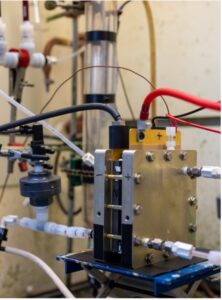Optimizing Battery Performance
Electrosynthesis Company has been developing and supporting the commercialization of redox flow battery technologies for more than 30 years. One of our key developmental tools is to test single cell batteries (as shown in photo) leading to cell stack testing at scales ranging from 10 cm2 (laboratory) to 0.7 m2 (commercial). The results of such testing help us screen and validate battery components, design-based performance, and stability.
Battery cells comprise various materials assembled in layers including bipolar/flow field plates, electrodes, gaskets, and membranes. Each component has its own role to make the battery operational and each will contribute to the internal cell resistance. A high performing battery will require the cell resistance to be as small as possible!
Our first step to reduce the cell resistance is to understand the composition of it. One of our skills is to diagnose the battery cell in-situ and identify the factor(s) limiting the battery performance using electrochemical impedance spectroscopy (EIS). Understanding the dominating factor(s), will facilitate how to improve the battery performance.
For the full article click Optimizing Battery Performance
